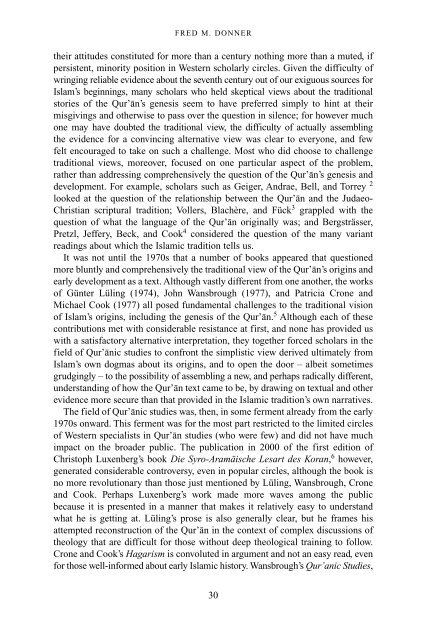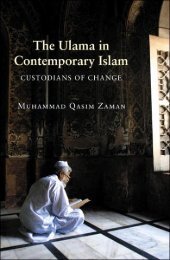The Qur'an in its historical context (pdf - Islam and Christian-Muslim ...
The Qur'an in its historical context (pdf - Islam and Christian-Muslim ...
The Qur'an in its historical context (pdf - Islam and Christian-Muslim ...
Create successful ePaper yourself
Turn your PDF publications into a flip-book with our unique Google optimized e-Paper software.
FRED M. DONNER<br />
their attitudes constituted for more than a century noth<strong>in</strong>g more than a muted, if<br />
persistent, m<strong>in</strong>ority position <strong>in</strong> Western scholarly circles. Given the difficulty of<br />
wr<strong>in</strong>g<strong>in</strong>g reliable evidence about the seventh century out of our exiguous sources for<br />
<strong>Islam</strong>’s beg<strong>in</strong>n<strong>in</strong>gs, many scholars who held skeptical views about the traditional<br />
stories of the Qur’an’s genesis seem to have preferred simply to h<strong>in</strong>t at their<br />
misgiv<strong>in</strong>gs <strong>and</strong> otherwise to pass over the question <strong>in</strong> silence; for however much<br />
one may have doubted the traditional view, the difficulty of actually assembl<strong>in</strong>g<br />
the evidence for a conv<strong>in</strong>c<strong>in</strong>g alternative view was clear to everyone, <strong>and</strong> few<br />
felt encouraged to take on such a challenge. Most who did choose to challenge<br />
traditional views, moreover, focused on one particular aspect of the problem,<br />
rather than address<strong>in</strong>g comprehensively the question of the Qur’an’s genesis <strong>and</strong><br />
development. For example, scholars such as Geiger, Andrae, Bell, <strong>and</strong> Torrey 2<br />
looked at the question of the relationship between the Qur’an <strong>and</strong> the Judaeo-<br />
<strong>Christian</strong> scriptural tradition; Vollers, Blachère, <strong>and</strong> Fück 3 grappled with the<br />
question of what the language of the Qur’an orig<strong>in</strong>ally was; <strong>and</strong> Bergsträsser,<br />
Pretzl, Jeffery, Beck, <strong>and</strong> Cook 4 considered the question of the many variant<br />
read<strong>in</strong>gs about which the <strong>Islam</strong>ic tradition tells us.<br />
It was not until the 1970s that a number of books appeared that questioned<br />
more bluntly <strong>and</strong> comprehensively the traditional view of the Qur’an’s orig<strong>in</strong>s <strong>and</strong><br />
early development as a text. Although vastly different from one another, the works<br />
of Günter Lül<strong>in</strong>g (1974), John Wansbrough (1977), <strong>and</strong> Patricia Crone <strong>and</strong><br />
Michael Cook (1977) all posed fundamental challenges to the traditional vision<br />
of <strong>Islam</strong>’s orig<strong>in</strong>s, <strong>in</strong>clud<strong>in</strong>g the genesis of the Qur’an. 5 Although each of these<br />
contributions met with considerable resistance at first, <strong>and</strong> none has provided us<br />
with a satisfactory alternative <strong>in</strong>terpretation, they together forced scholars <strong>in</strong> the<br />
field of Qur’anic studies to confront the simplistic view derived ultimately from<br />
<strong>Islam</strong>’s own dogmas about <strong>its</strong> orig<strong>in</strong>s, <strong>and</strong> to open the door – albeit sometimes<br />
grudg<strong>in</strong>gly – to the possibility of assembl<strong>in</strong>g a new, <strong>and</strong> perhaps radically different,<br />
underst<strong>and</strong><strong>in</strong>g of how the Qur’an text came to be, by draw<strong>in</strong>g on textual <strong>and</strong> other<br />
evidence more secure than that provided <strong>in</strong> the <strong>Islam</strong>ic tradition’s own narratives.<br />
<strong>The</strong> field of Qur’anic studies was, then, <strong>in</strong> some ferment already from the early<br />
1970s onward. This ferment was for the most part restricted to the limited circles<br />
of Western specialists <strong>in</strong> Qur’an studies (who were few) <strong>and</strong> did not have much<br />
impact on the broader public. <strong>The</strong> publication <strong>in</strong> 2000 of the first edition of<br />
Christoph Luxenberg’s book Die Syro-Aramäische Lesart des Koran, 6 however,<br />
generated considerable controversy, even <strong>in</strong> popular circles, although the book is<br />
no more revolutionary than those just mentioned by Lül<strong>in</strong>g, Wansbrough, Crone<br />
<strong>and</strong> Cook. Perhaps Luxenberg’s work made more waves among the public<br />
because it is presented <strong>in</strong> a manner that makes it relatively easy to underst<strong>and</strong><br />
what he is gett<strong>in</strong>g at. Lül<strong>in</strong>g’s prose is also generally clear, but he frames his<br />
attempted reconstruction of the Qur’an <strong>in</strong> the <strong>context</strong> of complex discussions of<br />
theology that are difficult for those without deep theological tra<strong>in</strong><strong>in</strong>g to follow.<br />
Crone <strong>and</strong> Cook’s Hagarism is convoluted <strong>in</strong> argument <strong>and</strong> not an easy read, even<br />
for those well-<strong>in</strong>formed about early <strong>Islam</strong>ic history. Wansbrough’s Qur’anic Studies,<br />
30



